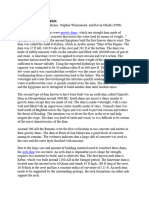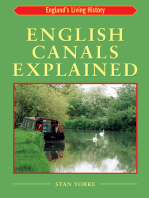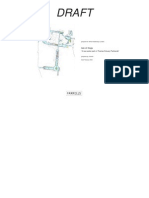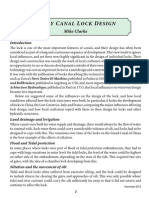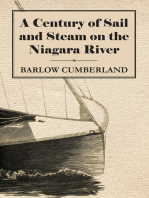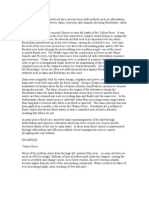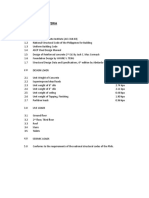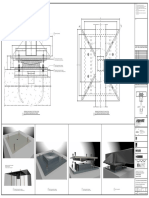HISTORY
“
Over three quarters of the surface of The earth is covered by water. Under The conditions of limited buildable Land, or to a lesser extent, simply Taking advantage of the resourceful and a-stimulating Environment, the idea of waterborne development has been demonstrated
By projects such as the Ponte Vecchio in Florence;
Chateau de Chenonceau On the River Cher near Paris; Edgar J. Kaufmann House in Bear Run, Pennsylvania; Palace Pier in Brighton England.
America of the Nineteenth century, the cities were Impatient with their natural water Boundaries. Almost 60 percent of the Old city Boston was under water including The entire Back Bay District; the Chicago lakefront contains more Than 2,000 acres of land that were once under the surface of Lake Michigan. The use of water frontier for urban development has also been applied through history. Venice was first settled as a refuge
by
mainlanders fleeting Atticas hordes in the fifth century.
”2
An Investigation of Implications of Waterborne and Hillside Development
Floating
“
A scoreful of proposed projects and studies such as the Triton City, made up of a proto-type floating neighbourhood community of 5,000 residents was suggested by the Triton Foundation under the direction of Buckminister Fuller; the Sea City for 33,000 inhabitants, floating off the coast of England, was proposed by the English architect Moggridge and Martin; the Urban Matrix proposed by Stanley Tigerman of Chicago; a residential bridge for
Zurich was proposed by architect Hugo Wandeler; the Urban Expansion Plan for Helsinki was suggested by a group of Finnish architects and the Tokyo Plan proposed by Kenzo Tange Group, further illustrated the ideas and possibilities of utilizing the natural landscape. Basically, there are some common constraints and factors that might alter the planning and design of waterborne development
”2
An Investigation of Implications of Waterborne and Hillside Development
Holland is probably to be the first floating country, in which the notion of housing is
transforming into amphibious homes. Floating structures are already part of country’s urban
planning. To see the old boat turned into a house on the channels of Amsterdam is not uncommon scene
–
some are even provided with terraces or small gardens. But further along the Amstel River one could find real design houses floating on the water.4
flexible architecture
Indian examples of floating dwellings are
DAL in Kashmir, Kerala in Dal their resides a whole settlement/society who live on houseboats, use it for tourist purpose, also do farming on dal to meet there needs and also to trade.
AQUATECHTURE
“
Water plays a vital role in shaping our built environment, as it has done for centuries. We depend on it, we use it, we live with it and we must respect it.
Aquatecture
is the new ways
of ‘designing for water,’ using examples from around the world to illustrate methods of
utilizing water innovatively, efficiently and safely
”
.3
Aquatecture: Buildings and cities designed to live and work with water
“
R. Buckminster Fuller's floating Triton City employed the tetrahedron's stability and prefabrication in its formation. An advocate of inventiveness and ecology, Fuller continues to seek ways for humanity to conserve and share the resources of our spaceship Earth.
UNDERWATER DWELLINGS AND SEA BORN STRUCTURES
Floating house Netherlands
“
In 1966, Paul Maymont proposed a floating village for Monaco. Resembling a huge stadium, the terraced dwellings step down the interior of the dished structure. Stanley Tigerman exploited the geometric hemioctet space frame concept in his 1968 U.S.A. Urban Matrix. Jacques Covell and Damaz-et Weigel imply a biological model in their amorphic dwellings clustered about courts and tied by bridges in their 1970 Floating Village for San Martin
.”
1
UNDERWATER DWELLINGS AND SEA BORN STRUCTURES PILE DWELLINGS
pile dwellings around the Alps is a series of prehistoric pile-dwelling or stilt house) settlements in and around the Alps built from around 5000 to 500 B.C. on the edges of lakes, rivers or wetlands. 111 sites, located in Austria 5 sites), France 11), Germany 18), Italy 19), Slovenia 2), and Switzerland 56), were added
to UNESCO World Heritage Site list in 2011. In Slovenia, this is the first cultural world heritage site.
INTERNET
dykes aquatecture
-
“Dutch water towns (grachtensteden)
T h e early Dutch settlements were established on natural high ground , ground above high-tide level, on islands, on secure ground that occurs a t the confluence of rivers, geest ground , an d on ground raised with dykes. I n the western lowlands, sites for settlements ha d to be drained , consolidated an d the level raised to provide the basis for grachtenstadt. T h e development of trade gave importance to settlements accessible to rivers and coast, settlements that also required moats for protection. The dyking of rivers an d the construction of canals to protect the dykes represented early eflbrts to improve trade and communications. The dykes were constructed wide enough for a road to be formed along the top and buildings erected on the dyke bank
- Amsterdam T h e seventeenth-century development of Amsterdam represents the boldest a n d most extensive feat of canal-town planning . Amsterdam was only a small fishing village during the early thirteenth century. I n 1240 a dam was constructed across the Amstel, to form a n inner and outer harbour, an d the main stream was divided into two channels leading to the sea. The original Amstel dykes provided route s for the first long streets of the future city. The narrow lanes that cross them were formerly field paths. Buildings on either side of the inner and outer harbours originally fronted directly onto the water to permit easier handling of goods from ships. Toward s the end of the sixteenth century the plan of the three canals was put forward as a solution to further extension. The scheme was put into operation early in the seventeenth century with the three wide concentric canals and streets (forming the characteristic long and narrow building blocks) an d an extensive five mile ring of fortifications incorporating bastions an d gates. The plan included
sites for public buildings an d a spacious park, the Plantage .” 5
AQUATECTURE . Architecture and Water











